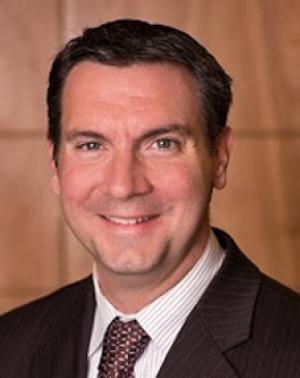Five questions for Scott Arthur

“Don’t Quit.” It’s the sentiment expressed on a plaque in Scott Arthur’s office on the CU Anschutz Medical Campus and a philosophy he follows as vice chancellor for advancement.
“People are sick, and we’re going to keep on raising resources until people aren’t. (Chancellor) Don Elliman reminds me every day that we have a dual purpose: delivering the best health care in the world today while reinventing the health care for tomorrow. If we can keep our focus, if we keep the conversations about transforming health care and not about the money, I don’t think we’ll quit.”
Arthur has been in his position at CU for just more than a year. Previously, he was vice president of constituent giving at the Nationwide Children’s Hospital Foundation in Columbus, Ohio, and a major gift officer for the Mayo Clinic in Rochester, Minnesota. He also co-founded a nonprofit to assist inner-city youth.
While Arthur worked at the Mayo Clinic, Colorado was his territory. He often saw the Anschutz Campus and thought it would be an interesting entity with which to be involved. When the job opened up, he applied. “I’m pretty excited about the opportunity we all have here.”
As a father of four, he says his life is running and raising kids. And thinking about big ideas.
1. How did you choose a career path in fundraising, in particular, and in the medical arena? Was there a person or event that influenced you?
In college, I was mugged at gunpoint by three inner-city youth and my life flashed before me – it was short and uneventful – so I decided to work to understand the urban community. I received my graduate degree at Case Western Reserve University in nonprofit management and fundraising. And during that time, I started a nonprofit that taught inner-city youth entrepreneurship skills after school. I had a partner who oversaw the program side and I did the fundraising. That after-school program morphed into a charter school, and now there are 11 charter schools in our network. They do some really neat things in Ohio. And they showed me the power of philanthropy in the nonprofit sector and what we can do for communities.
We also had a family situation with my son. I used to believe that nothing was more important than education, but then I realized you need to be healthy before you can get an education. That experience with my son is what drove me to learn about the Mayo Clinic and really learn about the medical and health care fundraising culture and industry. Mayo Clinic was a great training route for me.
2. How do you inspire philanthropy in your role as vice chancellor for advancement?
A big part of my time entails partnering with faculty and campus leaders and thinking about bigger, visionary ideas that could inspire transformational philanthropy. It’s connecting the dots between divisions and schools and centers and finding that sweet spot and the narrative around what we can do together as a campus. During this first year, we’ve been changing the narrative on the campus from a need-based fundraising narrative – “this is what I need” – to a vision-based narrative, or “this is where we’re going, the water is warm, please join us.”
It‘s about great stewardship and that means showing the impact of gifts and earning the right to have additional conversations with philanthropists. So I spend a significant time with faculty and I do a lot of coaching and mentoring of my staff, who are a great team of development officers.
3. What is the philosophy surrounding fundraising at CU Anschutz?
The philosophy that we want to bring to the Anschutz Medical Campus is one of joy and big ideas. People in this world constantly want to be inspired. If we focus on the money, we will lose every time. If we focus on the meaning, we will win. We must focus on impact, meaning and joy and the work with our faculty and our benefactors. If we do that, the money will come. If we focus on the money, people will feel that is our intention. We are transforming medicine, not fundraising.
4. What are some of the big ideas that you have already implemented or are pursuing?
There’s a lot of energy around mental health from community leaders and philanthropists. This is an area we want to explore. There is also an opportunity we’re creating called “venture philanthropy” where we fund higher-risk, higher-reward research projects that might have commercial viability. We invest in those projects and whenever there’s a monetization of the project, profits go back to the fund and it becomes an evergreen fund to support research and innovations.
5. Your annual goal is to raise $70 million. What are the hurdles of raising that much money every year?
This year was a terrific year; we raised $100 million. One of the hurdles of raising that much every year is creating a development operation that will sustain that type of support. We’re interested in how we engage with our faculty. Patients have a great amount of gratitude for what our faculty has done, and we’d be remiss if we didn’t give them an opportunity to show their appreciation. To rob grateful patients of that joy is a tragedy and it’s something we really want to focus on in the next several years – to create a more sophisticated grateful patient program.

